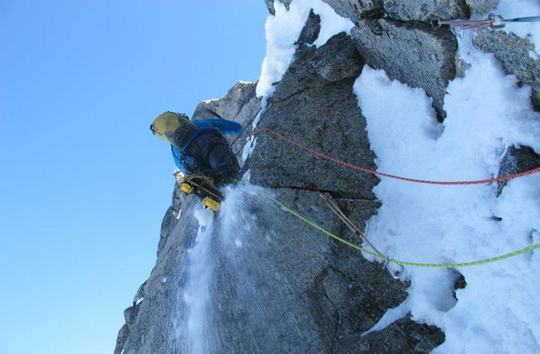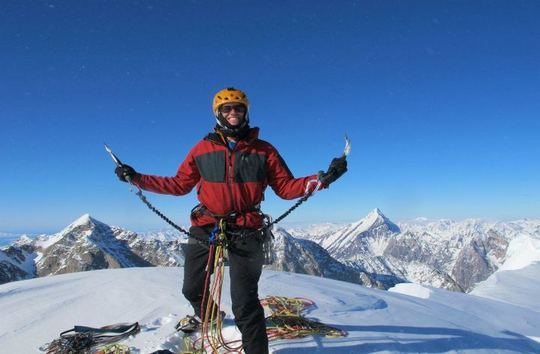Deep in the Alaskan wilderness, a hidden range of mountains called the Revelations rises in dramatic profile. After five trips to these hallowed mountains, I have managed to make five first ascents. Two of these trips were supported by the Mugs Stump Award.
Golgotha (8,940′)
In late March and early April, Ben Trocki and I made the first ascent of the Golgotha (8,940′) and the second ascent of the Angel (9,260′) via a previously unclimbed route. Perhaps only a few people have ever heard of the Golgotha and fewer have seen it. We were the first team to even make an attempt on the beautiful peak. The Golgotha’s sheer north face is guarded by a terrifyingly massive hanging glacier. Its east face however is complex and offers several climbable lines. On the first trip to the Revelations in 1967, Ned Fetcher called the east face of Golgotha “a route for the next generation.”

The monumental east face of Golgotha (8,940′) on the flight in. We attempted a direct ice line that begins at the crescent hanging snowfield and shoots straight up the face to the summit. Spindrift and deteriorating weather forced us out (twice) but we still reached the summit via the main rampy couloir on the left and then to the southeast face on left. [Photo] Clint Helander
After four trips to the range, I had figured out how to access certain areas. Getting to Golgotha’s east face required a fair amount of work. Soon enough, Ben and I found ourselves under Golgotha’s incredible east face. A vein of ice coursed from the summit, never more than a few feet wide. We climbed a wide couloir and traversed right to the base of the route, just as it started to spindrift. The weather deteriorated quickly, and Ben and I discussed our options. The couloir continued upward, and we decided that we may as well take advantage of the altitude we had already gained. Moderate climbing lead us to the crest of the southeast ridge. We were now fully exposed to harsh winds that froze our eyes shut whipped our ropes fifty feet to the side. We simulclimbed most of the upper face and soon found ourselves only several hundred feet below the summit. We clung to the mountain as 70 mph gusts tried to rip us from the slopes. Our howls were carried away on the corniced summit.
David Roberts, who gave the mountain its name, believed Golgotha to be the Revelation’s hardest-to-reach summit. As we descended and returned to camp 17 hours after starting, I felt almost as if I had cheated the mountain. For years I had built Golgotha up in my mind. Our premier line, the one we were spindrifted off of, would indeed be difficult. Part of me wished we had waited to summit the peak via the direct line.
The next day we returned to camp to find it completely buried. Our Megamid was knocked over and covered with a three-foot wind slab, and our tent had been crushed. Some storm. I couldn’t believe we’d summited in those conditions.

The Angel (9,265′), Revelation Mountains, Alaska. Helander and Trocki climbed the left-hand ridge that was first attempted in 1967 but never completed. [Photo] Clint Helander
The Angel (9,265′)
In 1967, David Roberts and his party were obsessed with the Angel. Excellent granite defines the mountain. During their astounding, 52-day stay in the Revelations, they made six serious attempts on its south ridge. It is without a doubt the mountain’s “classic” line. On August 28, 1967, Matt Hale and David Roberts made one final trip up to ridge with the sole intent of removing the last remnants of their gear. For six weeks they had been plagued by lashing winds, driving rain and biting sleet. Yet this day dawned perfect, the best weather of the entire trip.
Roberts and Hale made quick time to their highpoint and could not resist moving higher. In the early afternoon they found themselves only 700 feet below the summit, but an ice traverse separated them from the easier upper slopes. With anguished reluctance, they turned around since they were not prepared for a full on ascent or bivouac.

Trocki leading on the Angel. [Photo] Clint Helander
To this day, Roberts states that “of all my regrets from my years in the mountains, in terms of sheer what-might-have-beens, letting the Angel slip through my fingers when we were within 700 feet of the summit on a perfect day stings the sharpest.”
Seth Holden and I had previously attempted the Angel’s south ridge in 2010. We turned well below Roberts’ and Hale’s highpoint. In the early hours of April 3, Ben and I launched on the south ridge. With my knowledge of the route and without the cumbersome weight of bivy gear, we moved quickly to my previous highpoint. Consistently engaging climbing made the route absolutely fun, with sections of technical terrain to make it challenging at times. We reached the ice traverse that had stopped Hale and Roberts in the late afternoon and then the summit roughly two hours later. As I stood on the summit for the mountain’s second ascent, I felt a surging sense of pride in completing a route with such tremendous history.
We made one rappel into a major couloir on the mountain’s southwest face and downclimbed 3,500 feet to the valley floor. We then traversed east around the mountain to pass between the Angel and the Hydra. We skied down the glacier under a full moon and reached camp 21 hours after leaving.

A happy Helander on the summit of the Angel. [Photo] Ben Trocki
We made another attempt on Golgotha’s east face, but more spindrift shut us down. Then we attempted an incredible ice line on another unclimbed peak with the same results. Both attempts gave us wonderful insight to succeed in the future.
After 18 days we were almost out of food. We packed up camp and headed out, but not before making the third ascent of the Vanishing Pinnacle. David Roberts’ party climbed this little tower above camp, and it was repeated twenty years later by Greg Collins and Tom Walters. On the summit we found the original three-piton anchor and Collins’ webbing. I removed two of the pitons as souvenirs.
With that, we skied 25 miles out to a remote hunting lodge and were soon enjoying beers in Anchorage. It was a truly wonderful time in the mountains, and I thank the Mugs Stump Award for making it all possible.